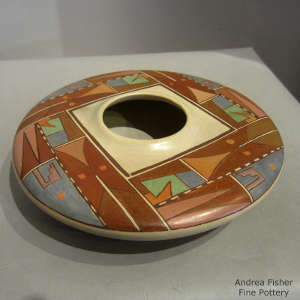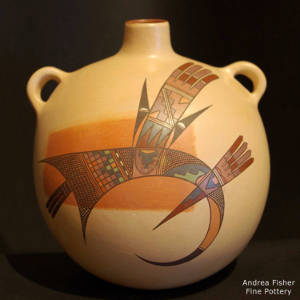Nathan Begaye
Hopi
Nathan Begaye was born to a Hopi mother and Navajo father in Phoenix, AZ in 1958. He was raised by his maternal grandparents at Third Mesa and in Yuba City, AZ. He expressed an interest in working with clay around the age of 10 and had his first public show at the age of 11. His upbringing included deep learning in the lore, customs, religion, symbolism and history of both the Navajo and Hopi peoples. He also learned the basic fundamentals of pottery production as practiced by both tribes.
Nathan received a scholarship from the Southwest Association for Indian Arts and attended the Institute of American Indian Arts in Santa Fe, beginning at the age of 14. Later in life he attended the New York State College for Ceramics at Alfred University. Although his upbringing had been quite conservative his art developed in a rather unexpected and unorthodox manner with a "maverick sense of form, texture, color and design." He often favored Hopi (Sikyátki) pottery styles but his designs varied back and forth through the symbolism of both Hopi and Navajo heritage. His work has sometimes been summarized as "Post Modernist Indian Pottery."
Nathan died in December, 2010.
Hopi Potters
- Hopi
- Karen Abeita
- Alice Adams
- Sadie Adams
- Loren Ami
- Ramona Ami
- Reva Polacca Ami
- Flying Ant
- Andrea Auguh
- Nathan Begaye
- Hattie Carl
- Bonnie Chapella
- Grace Chapella
- Karen Charley
- Lena Charlie
- Lowell Chereposy
- Debbie Clashin
- Kathleen Collateta
- William David
- Verla Dewakuku
- Preston Duwyenie
- Feather Woman
- Larson Goldtooth
- Vina Harvey
- Antoinette Honie
- Patricia Honie
- Daisy Hooee
- Rondina Huma
- Stella Huma
- Violet Huma
- Gloria Kahe
- Valerie Kahe
- Alton Komalestewa
- Jacob Koopee
- Claudina Lomakema
- Lorna Lomakema
- Steve Lucas
- Gloria Mahle
- Garrett Maho
- Patty Maho
- Amber Naha
- Burel Naha
- Helen Naha
- Nona Naha
- Paqua Naha
- Rainy Naha
- Sylvia Naha
- Tyra Naha
- Randall Sahmie Nahto
- Les Namingha
- Lillian Namingha
- Priscilla Namingha
- Bessie Namoki
- Lawrence Namoki
- Nampeyo of Hano
- Adelle Nampeyo
- Carla Claw Nampeyo
- Daisy Nampeyo
- Darlene Nampeyo
- Dextra Quotskuyva Nampeyo
- Donella Nampeyo
- Elva Nampeyo
- Fannie Nampeyo
- Gary Polacca Nampeyo
- Hisi Quotskuyva Nampeyo
- Iris Nampeyo
- James Nampeyo
- Leah Nampeyo
- Loren Hamilton Nampeyo
- Melda Nampeyo
- Miriam Nampeyo
- Nellie Nampeyo
- Neva Nampeyo
- Rachel Namingha Nampeyo
- Rayvin Nampeyo
- Tonita Nampeyo
- Charles Navasie
- Dawn Navasie
- Dolly Navasie
- Eunice Navasie
- Fawn Navasie
- Grace Navasie
- Joy Navasie
- Loretta Navasie
- Marianne Navasie
- Maynard Navasie
- Garnet Pavatea
- Clinton Polacca
- Thomas Polacca
- Vernida Polacca
- Laura Preston
- Alice Puhuhefvaya
- Al Qoyawayma
- Hisi Nampeyo Quotskuyva
- Marcia Rickey
- Jean Sahme
- Nyla Sahmie
- Rachel Sahmie
- Beth Sakeva
- Cynthia Sequi
- Dee Setalla
- Pauline Setalla
- Bobby Silas
- White Swann
- Dianna Tahbo
- Mark Tahbo
- Ted H. Tahbo
- Eli Taylor
- Marjorie Tewaguna
- Tyra Tewawina
- Unknown Hopi Potters
- Myrtle Young
- Ethel Youvella
- Nolan Youvella
- Susie Youvella
- Wallace Youvella



